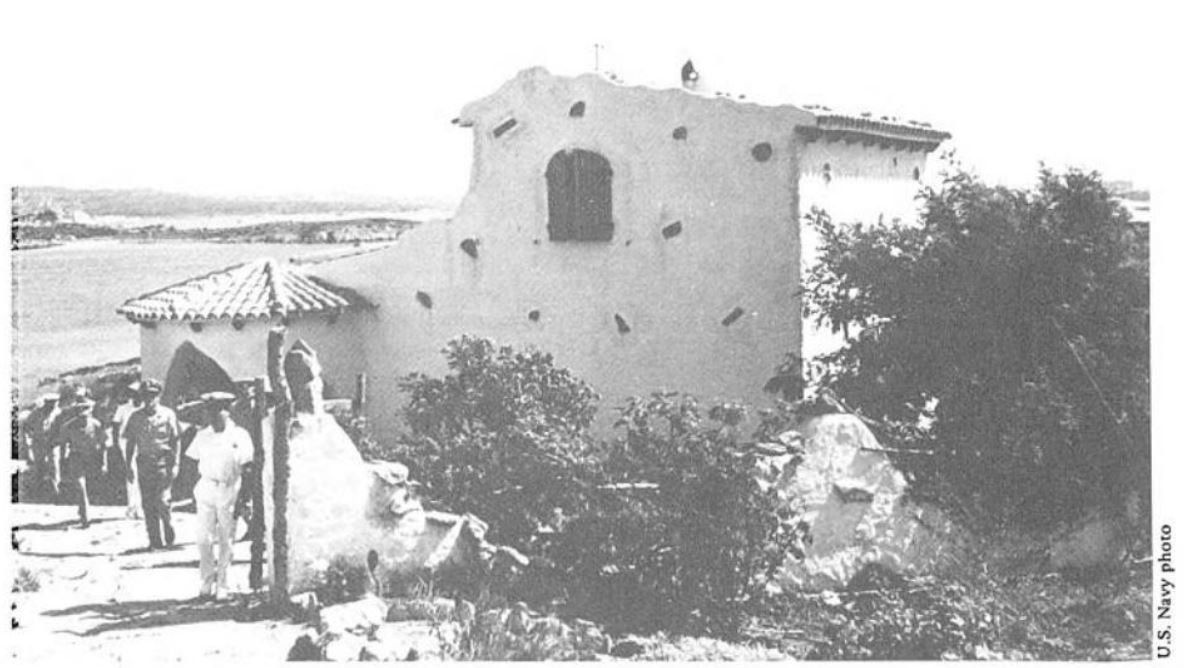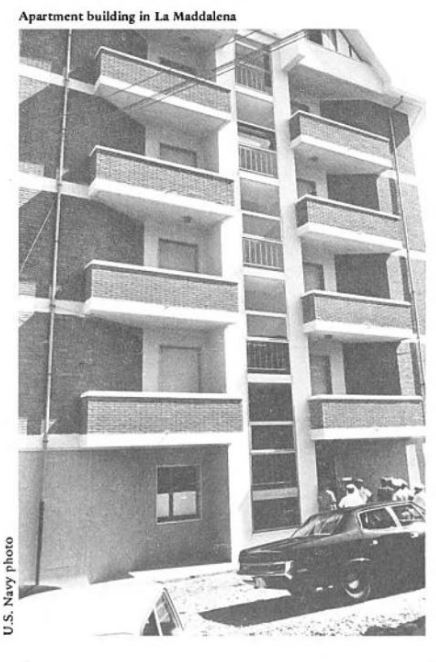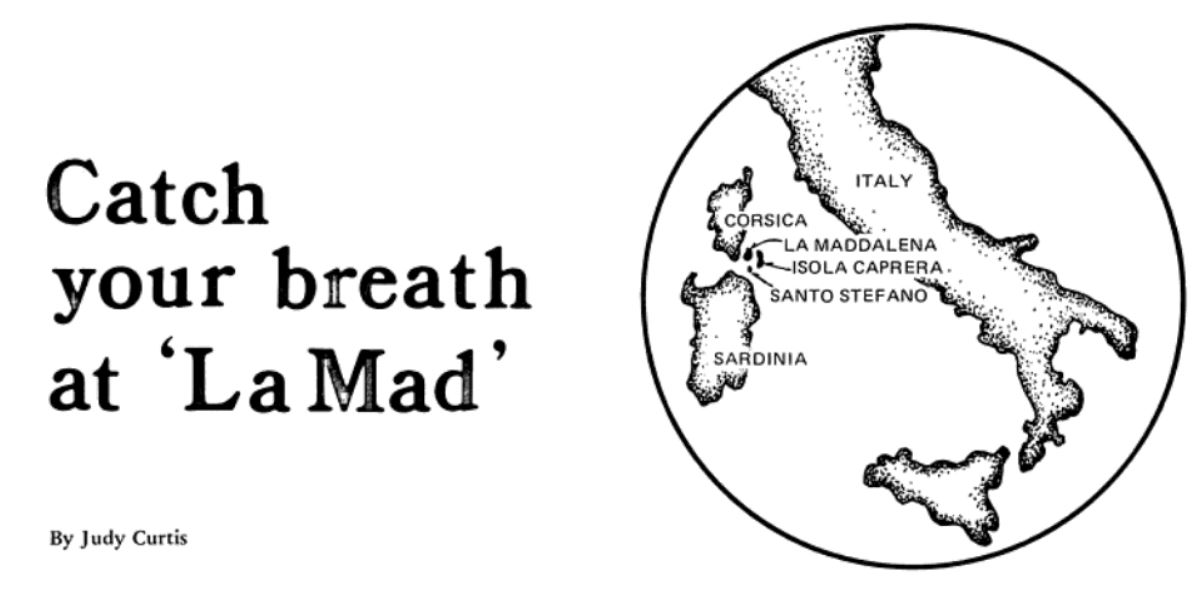CATCH YOUR BREATH AT ‘LA MAD’
di Judy Curtis
Judy Curtis was active in coordinating visits of submariners and their families and helping wives of Italian and American Navy men meet for cultural exchanges.
She and her husband were stationed in La Maddalena from summer 1975 to summer 1977.
Wifeline
The magazine for Navy families
Navy Internal Relations Activity, Department of the Navy
and
More than a year has passed since we left La Maddalena, Sardinia, to return to the United States. But impressions of “La Mad” remain vivid, and Sardinian experiences are still part of our conversations.
Now, the mention of La Maddalena sometimes evokes either a puzzled expression or the question, “Where’s La Maddalena?” Well, when I first heard of this place, I had to pull out our atlas to find that it is one of a group of islands lying off the northern tip of Sardinia, an island about 112 sea miles off Italy’s western coast.
Because of its strategic location in the Mediterranean, Sardinia has been invaded by Phoenicians, Carthaginians, Romans, Greeks and Spaniards, some of whose forts still stand outlined against the horizon. Thus, the people and their culture are a blend of these ancient invaders and visitors. Historical landmarks are reminders of Sardinia’s place in history, and archaeology buffs work their digs to discover Sardinia’s past. Divers still retrieve relics dating to 800 B.C.
Today at La Maddalena, the U.S. Navy, through an agreement between the Italian and American governments, maintains the Submarine Refit and Training Group, which was established in 1973.
The training group staff is actually located aboard the submarine tender, USS Howard W. Gilmore (AS 16), which is moored alongside a NATO pier on the nearby island of Santo Stefano, Consequently, the men take a boat to and from work a unique way to beat the rush-hour traffic.
The Naval Support Offices (NSO), which help new families with all of the settling-in details, are located on La Maddalena. The 300 or so families stationed there live on islands spread out over a 25-mile radius. Initially, lack of government housing and high rents (because of tourism) forced many Navy families to live farther away from work. However, as more Navy housing is built, families will move closer to the facilities and boat landings in La Maddalena and Palau.
“City” housing is in apartments like those found in cities throughout Europe. In smaller communities, stucco houses nestle in the rocks and blend with the terrain. At night, with the lights on, it seems there are twice as many houses as during the day. Some of the architectural features are unusual. We had two, eight-foot boulders in our living room which we used at Christmastime for our Nativity scene and Santa Claus display.
Recreational facilities such as the theater are within the NSO and most clubs and activities meet there.
Each year, as interests expand, more activities, including church groups, scouts, and hobby and language classes, are introduced.
Recreational facilities for the men aboard Gilmore and for visiting submariners are available on Santo Stefano, which also has a commissary and exchange.
The Navy exchange on Santo Stefano carries the basic necessities, plus the overseas special order catalog. Supplies arrive by helicopter from a supply ship that anchors out beyond the islands. Clothing, particularly children’s, is limited so it is best to make it yourself, or get it through a department store mail-order catalog. Italian clothes are exquisite, but prices can limit purchases.
The dispensary on La Maddalena provides medical and dental outpatient treatment. Medical personnel at the Naval Hospital or the Regional Dental Center in Naples, Italy, take care of the more complicated problems on a space-available basis. When you’re finished with the appointments, it’s a treat to shop at the large exchange at the Naval Support Activity in Naples.
A new Department of Defense school, with grades from kindergarten to ninth, opened on La Maddalena in 1975. Appropriately named Vista Mare, the school offers a breathtaking view of the sea. The building is Italian in design, but the school has mostly American teachers and format. High school students attend a boarding school near Madrid, Spain, or one of the local Italian schools.
Sardinia possesses an unusual terrain. Weatherworn rocks take on a sculptured look and the trees, which sparsely dot the islands, lean in the same direction, testifying to prevailing westerly winds. Miniature flowers grow between rocks and birds hide in the underbrush.
Rainy winters with strong, chilly winds make woolens necessary, even though temperatures remain above freezing.
Summer temperatures reach 90 degrees but the air doesn’t feel hot. The wind blows away humidity as well as insects so windows and doors don’t need screens. Drying clothes outside can be chancy because of sudden storms, and one learns to read the sky before hanging them out. Summer extends from May to mid-October, with most days having clear skies.
We enjoyed the swimming while stationed in La Maddalena. The water is so clear you can see the bottom of the sea which is 35 feet deep in places. Beaches, sandy and rocky, abound and vary from long stretches to hidden coves.
The pleasant combination of terrain and climate makes Sardinia an ideal resort area. The Costa Smeralda, which the Aga Khan developed, lies on the east coast of Sardinia, less than an hour away, including a 10-minute ferry ride from La Maddalena. An evening stroll along the waterfront in Porto Cervo, a town in the center of this area, takes you along a yachter’s dream. All types of boats, many longer than 80 feet, line the piers. Here, too, Americans can enjoy a magnificant golf course and a tennis club.
A trip by air or an overnight ferry ride makes several countries, including Spain and Italy, accessible for those with a yen for travel. Wives and children may travel “space A” unaccompanied by their sponsor a bonus for those on isolated duty.
Duty in Sardinia gave us the opportunity to share in another culture. Learning even a little of the Italian language opened doors to many friendships. Some of the highlights of our tour were the meals of Spanish, African and Italian origin that we enjoyed in Sard homes, exchange weekends with students and families in southern Sardinia, dances with friends in the Italian navy, and Christmas caroling in Palau.
The Sards celebrate wholeheartedly and everyone joins in at festival time. A month in advance of the Italian Mardigras, children dress in exquisite costumes and parade in them each afternoon.
In May, the Sardinians celebrate the Calvacado in Sassari, a city near Sardinia’s northwestern coast. Representatives from each city and town parade in their native costumes and the spectators judge the wealth of the town by the costumes.
People from the wealthiest towns wear gold-embroidered clothing and necklaces that have been passed down through the generations. The poorer, more isolated towns’ residents parade in darker, more sedate outfits.
Sards seem to enjoy the foods and celebrations of American Thanksgiving and Christmas, but they don’t emphasize Santa Claus on Dec. 25. For them, that day is strictly religious. They wait until Epiphany on Jan. 6 for their Santa Claus to arrive bearing gifts.
Reactions to Sardinia vary. Culture shock is usually brief as new arrivals adapt to a more relaxed lifestyle one which knows there’s always tomorrow.
Difficult moments do crop up as a result of the language barrier, so a sense of humor helps keep a good perspective. Just picture yourself trying to fix the car or washing machine. Talking to mechanics and plumbers in Italian is a real challenge, but body language and a good dictionary can save the day.
Despite the beauty of land and sea and the family activities, isolated duty can mean lonesome moments. Sardinia seems far removed from civilization and limited communication magnifies these feelings. Only a few telephones and some two-way radios link together the American families. However, since most of us have cursed the ringing of the telephone at some time, being incommunicado can be a real blessing!
The Sardinian lifestyle also remains untouched by commercialism. People horrified by the sight of Christmas displays before Halloween will be delighted that Christmas decorations are not available here until mid-December.
Friendships that develop among American families stationed in Sardinia are strong and long-lasting. We particularly value sharing the experiences we have all had. Here, members of the family learn to take time to enjoy each other. Games, puzzles and reading replace television. Children of all ages play together and especially enjoy hiking, exploring and rock climbing.
Sardinia is a unique experience. We had requested duty there and would again. The children thrived and we enjoyed the chance to catch our breath. My advice? Take two years off from the hustle and bustle of stateside living and try La Maddalena, Sardinia.
Health Care in Sardinia
Readers respond…
Dear Wifeline: Reference is made to the article in the fall issue of Navy Wifeline by Judy Curtis. “Catch Your Breath at La Mad.” To it I would like to add a line or two about Navy health care in Sardinia.
The Branch Clinic at La Mad is staffed by two primary care medical officers, two nurses and six hospital corps-men. Laboratory and X-ray facilities are limited to simple tests and X-ray studies. More complicated tests and exams must be done in Naples.
Every month an obstetrician, a surgeon and an optometrist visit La Maddelena for a day of consultations and eye refractions. Babies are born at Naples under a program where the mothers move into the medical center a week or so before the baby is due and return to Sardinia when the baby is three to five days old.
For consultations in specialties other than those covered by the monthly visits, and for consultations that can’t be delayed, patients travel to Naples on the scheduled Military Airlift Command flights Monday, Wednesday and Friday. Patients with urgent medical problems must be moved to Naples or Germany by emergency airlift.
Transportation of patients is rather involved. The normal times for movement are 20 minutes by boat from La Maddelena to the main island of Sardinia at Palau, an hour or so by road to Olbia where the airport is located, an hour and one-half by air from Olbia to Naples, and half an hour by freeway from Naples Air- port to the medical center. Emergency airlift is a little more complicated. The airport at Olbia is closed after dark so all but the most urgent clinical problems that occur at night must remain in the Branch Clinic to await daylight. Emergency MEDEVACs originate either in Sigonella, Italy, or in Frankfurt, Germany. The mini- mum time from call-up of the MEDEVAC to arrival of the patient at USNRMC Naples is five hours. The trip to Germany takes longer.
Some kinds of health problems may be difficult or even impossible to manage in La Maddalena because of the small size of the Branch Clinic, the relatively limited scope of services at Naples, and the aforementioned difficulties with transportation. La Mad has two primary care medical officers. Naples has 18 medical officers in the fields of general medicine, family practice, internal
medicine, pediatrics, general surgery, orthopedic surgery, ophthalmalogy, obstetrics, gynecology and psychiatry. Naples does not have urology, neurology, neurosurgery, ear-nose-throat, allergy, dermatology, or any of the important surgical, pediatric and internal medicine subspecialties. Patients requiring care in these specialties must go to Germany or, occasionally, to CONUS. Outpatient visits to Germany take about a week and are very expensive because of the high costs of hotels, meals and taxicabs.
A significant health problem in any family member may be a reason to decide not to come to La Mad. Some examples are: insulin-dependent diabetes, uncontrolled seizure disorder, symptomatic congenital heart disease, significant behavior problem or learning disability, history of severe mental or emotional disorder, chronic or progressive disabling diseases of any kind, recent or ongoing treatment for cancer, blood clot- ting disorder, severe asthma or allergy, history of child abuse or spouse abuse, and alcoholism with less than a year and one-half of sobriety since treatment.
Any family with a question about the capability of our system to care for its particular health problems is invited to write to me or discuss the matter with me by telephone before coming to Sardinia.
- V. Cooley, Captain, Medical Corps Commanding Officer U.S. Naval Regional Medical Center Naples, Italy, Box 19 FPO New York 09521 AUTOVON 625-1110/Ext. 4230/4231
We appreciate Captain Cooley’s information about the medical care situation in Sardinia and are glad to share it with our readers. We welcome similar responses from all of our readers. Ed.



